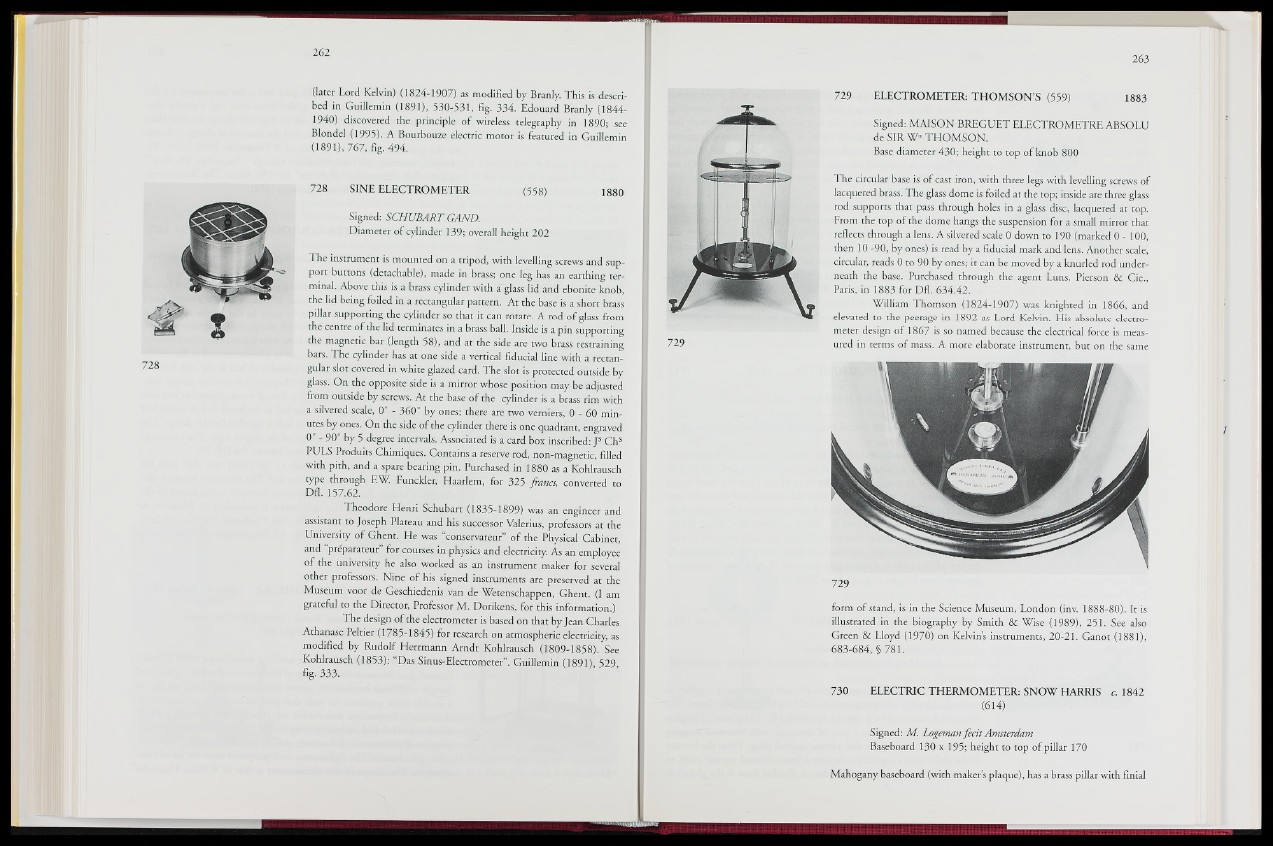
(later Lord Kelvin) (1824-1907) as modified by Branly. This is described
in Guillemin (1891), 530-531, fig. 334. Edouard Branly (1844-
1940) discovered the principle of wireless telegraphy in 1890; see
Blondel (1995). A Bourbouze electric motor is featured in Guillemin
(1891), 767, fig. 494.
728 SINE ELECTROMETER (558) 1880
Signed: SCHUBART GAND.
Diameter of cylinder 139; overall height 202
The instrument is mounted on a tripod, with levelling screws and support
buttons (detachable), made in brass; one leg has an earthing terminal.
Above this is a brass cylinder with aglass lid and ebonite knob,
the lid being foiled in a rectangular pattern. At the base is a short brass
pillar supporting the cylinder so that it can rotate. A rod of glass from
the centre of the lid terminates in a brass ball. Inside is a pin supporting
the magnetic bar (length 58), and at the side are two brass restraining
bars. The cylinder has at one side a vertical fiducial line with a rectangular
slot covered in white glazed card. The slot is protected outside by
glass. On the opposite side is a mirror whose position may be adjusted
from outside by screws. At the base of the cylinder is a brass rim with
a silvered scale, 0 - 360 by ones; there are two verniers, 0 - 60 minutes
by ones. On the side of the cylinder there is one quadrant, engraved
0° -.'90° by 5 degree intervals. Associated is a card box inscribed: Js Chs
PULS Produits Chimiques. Contains a reserve rod, non-magnetic, filled
with pith, and a spare bearing pin. Purchased in 1880 as a Kohlrausch
type through F.W. Funckler, Haarlem, for 325 francs, converted to
Dfl. 157,62.
Theodore Henri Schubart (1835-1899) was an engineer and
assistant to Joseph Plateau and his successor Valerius, professors at the
University of Ghent. He was “conservateur” of the Physical Cabinet,
and préparateur for courses in physics and electricity. As an employee
of the university he also worked as an instrument maker for several
other professors. Nine of his signed instruments are preserved at the
Museum voorMI Geschiedenis van de Wetenschappen, Ghent. (I am
grateful to the Director, Professor M. Dorikens, for this information.)
The design of the electrometer is based on that by Jean Charles
Athanase Peltier (1785-1845) for research on atmospheric electricity, as
modified by Rudolf Herrmann Arndt Kohlrausch (1809-1858). See
Kohlrausch (1853): “Das Sinus-Electrometer”. Guillemin (1 8 9 * 5 2 9 ,
fig. 333.
729 ELECTROMETER: THOMSON’S (559) 1883
Signed: MAISON BREGUET ELECTROMETRE ABSOLU
dc SIR W«-M IOMSON. ,
Base diameter 430; height to top of knob 800
The circular base is of cast iron, with three legs with levelling screws of
lacquered brass. The glass dome is foiled at the top; inside are three glass
rod Supports that pass through holes in a glass disc, lacquered at top.
From the top of the dome hangs the suspension for a small mirror that
reflects through a lens. A silvered scale 0 down to 190 (marked 0 -100,
¡then 10 -90, by ones) is read by a fiducial mark and lens. Another sUSfe;..
circular, reads 0 to 90 by ones; it can be moved by a knurled rod underneath
the base. Purchased through the agent Luns, Pierson & Cie.,
Paris, in 1883 for Dfl. 634.42.
William Thomson (1824-1907) was knighted in 1866, and
elevated to the peerage in 1892 as Lord Kelvin. His absolute electrometer
design of 1867 is so named because the electrical force is measured
in terms of mass. A more elaborate instrument, but on the same
729
form of stand, is in the Science Museum, London (inv. 1888-80). It is
illustrated in the biography by Smith & Wise (1989), 251. See also
Green & Lloyd (1970) on Kelvins instruments, 20-21. Ganot (1881),
683-684, § 781.
730 ELECTRIC THERMOMETER: SNOW HARRIS c. 1842
Signed: M. Logeman fecit Amsterdam
Baseboard 130 x 195; height to top of pillar 170
Mahogany baseboard (with makers plaque), has a brass pillar with finial